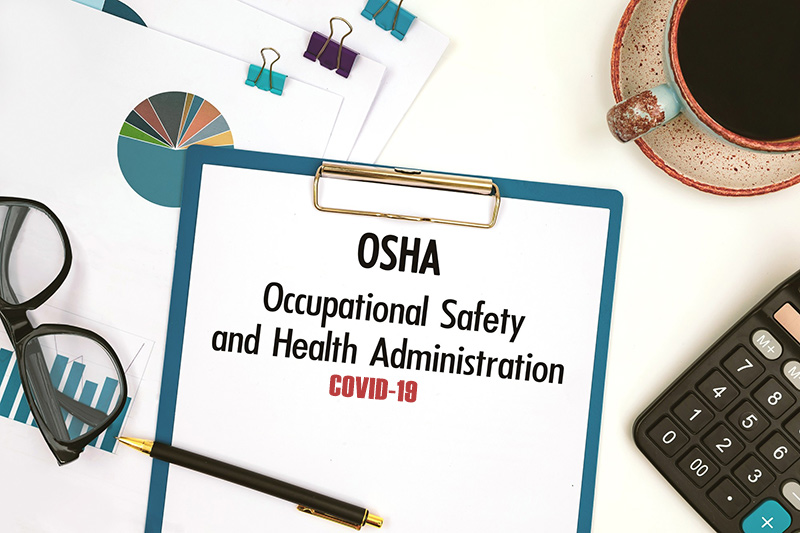Employers in different industry sectors need to be aware of the official regulations issued from time to time to stay compliant and ensure workplace safety for their employees. Workers’ compensation attorneys also stay abreast with these regulations so that they can provide the right legal advice to their clients as regards workplace and employee safety. As a company providing medical record review for attorneys, MOS also follows such updates closely. One such important regulation that came into effect on June 21, 2021 is OSHA’s First Emergency Temporary Standard (ETS) that is aimed at limiting the spread of COVID-19 in the workplace. The mandatory standards apply only to the healthcare sector. The ETS is applicable to workers who provide healthcare and healthcare support services and includes doctors, nurses, emergency medical personnel, oral health professionals, workers who provide services in patient admission, equipment and facility maintenance, food service, housekeeping, medical equipment cleansing and reprocessing, and medical waste handling. Healthcare sector employers are required to comply with the ETS that comprises mandatory practices and procedures.
What Are the Exemptions Allowed?
The following are exempted from coverage:
- Pharmacists dispensing prescriptions in retail settings
- Provision of first aid by an employee who is not a licensed healthcare provider
- Healthcare support services that are provided in off-site, non-healthcare settings such as billing and coding services, laundry, or medical waste handling
- Non-hospital ambulatory settings where all non-employees are screened before entry and people with suspected/confirmed COVID-19 are not permitted to enter
- Employees working in hospital-based outpatient clinics or home healthcare settings, provided that all employees (except those who are exempt from vaccination because of disabilities or religious exemptions) are fully vaccinated, and all non-employees are screened for COVID-19 and are not permitted to enter if they are suspected/confirmed to have COVID-19.
- Telehealth services performed outside of a setting where direct patient care is provided.
What Are the Precautions Employers Need to Take?
Now, let us look at the precautions that employers are required to take to protect their employees from COVID-19 transmission in the workplace.
- Develop and implement an effective COVID-19 plan meeting certain parameters
- Be compliant with CDC guidelines as regards transmission-based precautions
- Screen patients and limit access to settings where direct patient care is provided
- Limit exposure to aerosol-generating procedures on a person who is suspected/confirmed to have COVID-19
- Provide PPE or personal protective equipment and ensure appropriate use by employees
- Be compliant with CDC guidelines regarding cleaning/disinfecting of surfaces
- Conduct regular health screening of employees and provide notice of positive COVID-19 cases
- Monitor ventilation systems
- Implement indoor physical distancing requirements and install physical barriers at fixed work locations in non-patient care areas
- Provide training related to COVID-19 transmission, procedures, and policies
- Provide reasonable paid leave for vaccination and vaccine side effects
- Establish a COVID-19 log of all employee instances (work-related or otherwise) of COVID-19. This is required only for employers who have more than 10 employees
- Provide notice to employees about the prohibition on retaliation for exercising rights available under the ETS
- Report work-associated COVID-19 fatalities and hospitalizations to OSHA.
Employers are required to comply with the ETS mandates by the 6th of July 2021, except for requirements regarding ventilation, physical barriers, and training. However, employers must become compliant with ventilation, physical barrier and training requirements by July 21, 2021.
According to the ETS, employers that provide respirators to employees are required to follow certain training, use, and maintenance standards. In workplaces that allow employees to provide their own respirators, employers are required to provide employees with a specific notice regarding respirator use and upkeep. All requirements must be implemented at no cost to the employees.
What about the Non-mandatory Guidance?
OSHA also released their updated non-mandatory guidance for industries other than the healthcare sector that focuses on safeguards or protections for at-risk and unvaccinated workers, and encouraging vaccination. For these workers, OSHA recommends measures such as implementing physical distancing, providing paid time off for vaccination, providing face coverings or surgical masks; requesting unvaccinated customers/visitors to wear face coverings, performing routine cleaning and disinfection, maintaining ventilation systems, and advising unvaccinated workers who had exposure to COVID-19 patients to stay home. Following similar CDC guidance, the ETS also states that most non-healthcare employers need not any longer take measures to protect their fully vaccinated workers who are not otherwise at risk from COVID-19 exposure.
Employers Must Stay Compliant
Regulations pertaining to workplace safety are very important and employers need to understand these regulations and stay compliant to avoid workers’ compensation claims, and processes such as medical peer review and other formalities, and increased workers’ compensation costs. OSHA’s ETS website provides FAQs, Fact Sheets, Notification Removal and Return to Work Flow Charts for employers as well as employees, employee training presentations, and other useful information. Already there are existing guidelines published by state and federal agencies such as the Centers for Medicare and Medicaid Services (CMS), and the Centers for Disease Control and Prevention (CDC) on similar COVID-19-related topics for healthcare providers. Employers in the healthcare sector need to carefully review all such related laws and agency guidelines, and an employment lawyer can be of great assistance in this regard.
Disclaimer: The content of this blog is sourced from reliable internet resources and is meant for informative purposes only. For more specialized information, please contact an employment attorney or visit OSHA’s ETS website.




